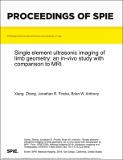| dc.contributor.author | Fincke, Jonathan Randall | |
| dc.contributor.author | Zhang, Xiang | |
| dc.contributor.author | Anthony, Brian | |
| dc.date.accessioned | 2018-04-20T17:37:35Z | |
| dc.date.available | 2018-04-20T17:37:35Z | |
| dc.date.issued | 2016-04 | |
| dc.date.submitted | 2016-04 | |
| dc.identifier.issn | 1605-7422 | |
| dc.identifier.issn | 2410-9045 | |
| dc.identifier.uri | http://hdl.handle.net/1721.1/114815 | |
| dc.description.abstract | Despite advancements in medical imaging, current prosthetic fitting methods remain subjective, operator dependent, and non-repeatable. The standard plaster casting method relies on prosthetist experience and tactile feel of the limb to design the prosthetic socket. Often times, many fitting iterations are required to achieve an acceptable fit. Use of improper socket fittings can lead to painful pathologies including neuromas, inflammation, soft tissue calcification, and pressure sores, often forcing the wearer to into a wheelchair and reducing mobility and quality of life. Computer software along with MRI/CT imaging has already been explored to aid the socket design process. In this paper, we explore the use of ultrasound instead of MRI/CT to accurately obtain the underlying limb geometry to assist the prosthetic socket design process. Using a single element ultrasound system, multiple subjects' proximal limbs were imaged using 1, 2.25, and 5 MHz single element transducers. Each ultrasound transducer was calibrated to ensure acoustic exposure within the limits defined by the FDA. To validate image quality, each patient was also imaged in an MRI. Fiducial markers visible in both MRI and ultrasound were used to compare the same limb cross-sectional image for each patient. After applying a migration algorithm, B-mode ultrasound cross-sections showed sufficiently high image resolution to characterize the skin and bone boundaries along with the underlying tissue structures. Keywords: limb imaging, prosthetic fitting, ultrasound, single element ultrasound, MRI | en_US |
| dc.publisher | SPIE | en_US |
| dc.relation.isversionof | http://dx.doi.org/10.1117/12.2216542 | en_US |
| dc.rights | Article is made available in accordance with the publisher's policy and may be subject to US copyright law. Please refer to the publisher's site for terms of use. | en_US |
| dc.source | SPIE | en_US |
| dc.title | Single element ultrasonic imaging of limb geometry: an in-vivo study with comparison to MRI | en_US |
| dc.type | Article | en_US |
| dc.identifier.citation | Zhang, Xiang et al. “Single Element Ultrasonic Imaging of Limb Geometry: An in-Vivo Study with Comparison to MRI.” Medical Imaging 2016: Ultrasonic Imaging and Tomography, April 2016, San Diego, California, United States SPIE 2016. © 2016 SPIE. | en_US |
| dc.contributor.department | Massachusetts Institute of Technology. Department of Mechanical Engineering | en_US |
| dc.contributor.mitauthor | Fincke, Jonathan Randall | |
| dc.contributor.mitauthor | Zhang, Xiang | |
| dc.contributor.mitauthor | Anthony, Brian | |
| dc.relation.journal | Medical Imaging 2016: Ultrasonic Imaging and Tomography | en_US |
| dc.eprint.version | Final published version | en_US |
| dc.type.uri | http://purl.org/eprint/type/ConferencePaper | en_US |
| eprint.status | http://purl.org/eprint/status/NonPeerReviewed | en_US |
| dc.date.updated | 2018-03-30T15:56:42Z | |
| dspace.orderedauthors | Zhang, Xiang; Fincke, Jonathan R.; Anthony, Brian W. | en_US |
| dspace.embargo.terms | N | en_US |
| dc.identifier.orcid | https://orcid.org/0000-0001-5112-9718 | |
| dc.identifier.orcid | https://orcid.org/0000-0002-3130-8337 | |
| mit.license | PUBLISHER_POLICY | en_US |
